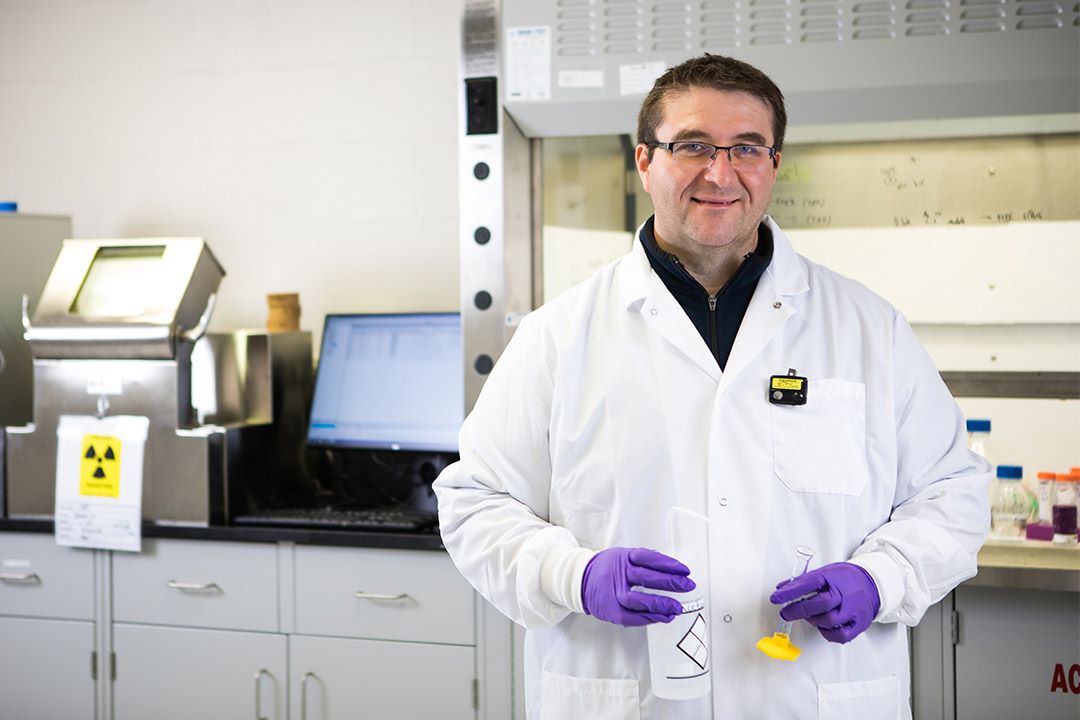
Illuminating enzymes
Innovation in radio-imaging techniques – promising to uncover once-invisible connections and unlock diagnostic tools and interventions – illustrates a powerful convergence at the University of Saskatchewan (USask).
By Innovation and Education Excellence reportWith a hub of research excellence that combines cutting-edge facilities with a culture of interdisciplinary collaboration, USask has created "an amazing ecosystem that allows innovation to move at an ever-faster speed," says Baljit Singh, the university's vice-president, Research.

Part of this momentum is driven by synergies, where insights from one area of research create ripple effects across multiple domains, and one example comes from the work of Dr. Chris Phenix, an associate professor of chemistry who leads the Phenix Research Group.
"Dr. Phenix looks at proteases, or enzymes, that are functional across multiple organisms, from plants to animals to humans," says Dr. Singh. "This is quite ground-breaking, because there are some shared tools that allow us to decipher genomic components and predict how they might influence biology – and how, when they go sideways, they may cause disease or abnormality in any of these systems."
Picture enzymes as "little molecular machines that have two jobs: One, to build the biomolecules that our cells need to maintain a healthy function, and two, to break them down, in short, to rejuvenate and recycle cell components," proposes Dr. Phenix, for whom this image inspires two key questions: "What happens when things go wrong and can we detect it? And what kind of interventions can help set things right?"
Yet before pursuing such inquiries, "we first have to be able to monitor enzyme activity," he explains. "My area of expertise is chemical tool development – and we're working to develop radioactive tracers."
Interest in glucocerebrosidase, or GCase, the enzyme at the core of the Dr. Phenix's efforts, was sparked when post-mortem studies found a drop in this enzyme's level in the brains of Parkinson’s patients, including early in the disease process.
"My grandmother had Parkinson's. I saw her dementia advance very quickly, and this has been a source of motivation for me personally, " he says. "I also learned from my neurology collaborators that by the time someone is diagnosed with Parkinson's, there is often already a considerable loss of function."
Currently, Parkinson's is primarily diagnosed through observing symptoms, and for Dr. Phenix, "there is a strong link between working on techniques to help with diagnosis and learning about the fundamental pathology of the disease, which could lead to the development of new treatments."
The challenge is considerable: "There must be 1,000 different enzymes in our body, and we need a radioactively tagged molecule that attaches itself to only one specific enzyme," he says, adding that precise measurements of "GCase activity in Parkinson's requires specialized imaging to peer inside the living brain."

The team is using fluorine-18 – a radioactive isotope produced at USask’s Saskatchewan Centre for Cyclotron Sciences – to develop radioactively tagged tracing agents that selectively attach to GCase to then be detected through positron emission tomography (PET) imaging.
The first round of compounds "was very promising," says Dr. Phenix. "We continue to make improvements, and we've also developed fluorescent derivatives, where we can shine a light to detect enzymes in immune cells in human blood. We have evidence these immune cells mimic what's happening in the brain."
The team is hoping to gain insights about disease progression and potential interventions from understanding how GCase is linked to the accumulation of alpha-synuclein, a protein crucial for nerve cell communication that forms toxic clumps known as Lewy bodies, a hallmark of Parkinson’s pathology, says Dr. Phenix, who appreciates "being at the forefront of basic science that can answer key questions about disease."
What makes USask uniquely suited for such complex investigations are "world-class facilities, including the cyclotron and radio pharmacy labs as well as imaging suites," he says. "We have a full-size PET/CT facility, the only place I know of where we can image a mouse, a pig, a plant and a human with the same radio tracer."
Medical isotopes are already improving health outcomes through enabling more precise and targeted diagnostics and therapies, and Dr. Singh says USask "is building on a 75-year-plus history of research in nuclear science – from Sylvia Fedoruk and Gerhard Herzberg to all the luminaries involved in developing the accelerator, the synchrotron and the Fedoruk Centre for Nuclear Innovation."
Decades-long efforts and investments have served to "build up scientific excellence and infrastructure to where we have cutting-edge facilities and outstanding researchers and training programs. That's how we're at a stage where these breakthroughs are possible," he says.
"These complex challenges cannot be solved in a day. What is required are sustained efforts to create this type of innovation environment, where we have a spread of disciplines and opportunities for collaboration," says Dr. Singh, who has a background in veterinary medicine, a field he believes "plays a key role in driving biomedical research benefits for animals as well as humans."
Medical scientists often rely on animal models to study not only the pathogenesis of a disease but also test new diagnostics and therapeutics – and the resulting data "is very relevant to the human condition," says Dr. Singh. "I'm hard pressed to find another university in the country that has all these disciplines and infrastructure that can be put at the service of humanity."
Within a 10-minute-walk radius from his office, Dr. Singh encounters the College of Agriculture and Bioresources, the Western Veterinary College, the College of Medicine, the Fedoruk Centre for Nuclear Innovation, the Canadian Light Source, the Vaccine and Infectious Disease Organization (VIDO) and Innovation Place, which houses the Global Institute for Food Security with "one of the most advanced plant genotyping platforms in Western Canada," and more.
The quest to "measure GCase activity in a living person, and especially in the brain where you can't get access to samples very easily," has inspired interdisciplinary collaboration, says Dr. Phenix, including USask pathology professor Darrell Mousseau, Alex Rajput from the Neurology and Saskatchewan Movement Disorders Program and Aarnoud Van der Spoel, a professor in the Department of Pediatrics at Dalhousie University.
While elevating GCase levels holds promise for slowing disease progression in Parkinson's, "we also noticed a flip side, where enzyme activity goes up in other diseases," he says. "In cancer, for example, these enzymes are hyperactive: they break down tissue around tumours to create pathways for the cancer to invade."
As a result, the enzyme-imaging tools for Parkinson's are "ready for cancer, where the radio tracers can be used for investigating tumours," Dr. Phenix says. "The synergy of doing experiments while having a big picture in mind allows us to apply our insights to different disease settings."
What's more, GCase activity is not limited to humans and animals. "We apply the same techniques to study related enzymes in canola. Saskatchewan is known for crop sciences, so after securing funding for human disease, we also dived into plant biology," says Dr. Phenix, who grew up on a Saskatchewan farm and whose efforts have attracted funding support from the Saskatchewan Health Foundation, the Michael J Fox Foundation and Parkinson Canada, among others.
There is also considerable interest from the private sector in radio nuclear technology developed at USask, adds Dr. Singh, "The world is watching as to what we can deliver."
Original article published at the Globe and Mail.Together, we will undertake the research the world needs. We invite you to join by supporting critical research at USask.

